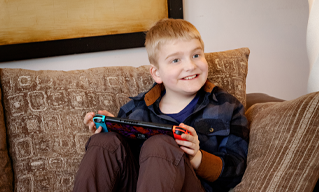
At Sarepta, our mission includes helping as many people living with Duchenne muscular dystrophy as possible. While scientific progress has led to transformative therapies for some, not every individual with Duchenne is eligible for these more advanced treatments. Caleb and Duncan Kasner are among those whose specific genetic mutation excludes them from most available options.
Their story offers a candid look at life with Duchenne as the disease progresses. It’s a reality shaped by physical limitations and the relentless march of a disease that touches every aspect of daily life. This portrait of the Kasners underscores the urgency of our work at Sarepta, which has helped catalyze scientific interest and accelerate developments in the treatment of Duchenne. Their experience is a powerful reminder of why continued advocacy and innovation matters.
In the crowded kitchen of their Minneapolis home, Sarah and Dan Kasner maneuver around two large power wheelchairs, two lighter-weight wheelchairs, a portable toilet and a Hoyer lift (a mechanical device used to help transfer people with limited mobility). In the next room, their sons, Caleb, 11, and Duncan, 10, play video games in oversized recliners. An elevator, added recently, provides access to the boys’ bedrooms and a wheelchair accessible bathroom on the lower level.
Caleb and Duncan (who goes by Dunky), live with Duchenne muscular dystrophy, a progressive and fatal muscle-wasting disease. When the boys were diagnosed at ages 4 and 3, the Kasners were stunned. “Before the boys were diagnosed, we didn't know anything about Duchenne,” recalled Sarah. “We vaguely knew what muscular dystrophy was but didn't know what Duchenne was until we Googled it.”
That initial search revealed a difficult truth: without intervention, the boys would gradually lose physical function and independence as Duchenne affected muscles throughout their bodies, eventually impacting their lungs and heart.
For Caleb and Dunky, the progression began subtly, struggling to keep up with other kids, then escalated: first they lost the ability to run, then the strength to climb stars and eventually, the ability to walk. Caleb stopped walking at age 8, and Dunky at age 9. Recently, Sarah noticed Caleb struggling to lift food to his mouth, so she switched to lightweight plastic utensils to make mealtimes easier. “A spoon is heavy. Can you imagine?” she said. “It’s things like that you never think will actually happen. And then, here we are.”
Watch the Kasner family discuss life with Duchenne in the video below.
When there is no treatment
“Here” is life with Duchenne without disease-slowing treatments. Duchenne is caused by a mutation within the dystrophin gene, one of the largest genes in the human body. Mutations, either deletions or duplications, can occur anywhere along the gene and interfere with the body’s ability to produce dystrophin, a protein that acts like a shock absorber when muscles contract. Without dystrophin, muscles progressively weaken and deteriorate.1
Caleb and Dunky’s specific mutation makes them ineligible for most new Duchenne treatments, which target only certain types of genetic changes. As a result, they rely on physical therapy and daily corticosteroids to help maintain muscle strength. However, these steroids come with significant side effects, including weight gain, behavioral changes, weakened bones, delayed growth and increased risk for infections.
And corticosteroids do not address the root cause of the disease.2
“When there is no treatment, Caleb and Dunky are basically what the disease will look like,” Sarah said.
All hands on deck
Duchenne is a variable disease, and in Caleb and Dunky’s case, it is progressing rapidly. “A lot more has changed in the past five years than I think either of us anticipated. It’s all happened so fast,” Sarah said. “First, we had one type of wheelchair, and then we needed the power chairs, and then all the other things. The disease has definitely taken a hold of them.”
Managing the progression of Duchenne has become a full-family effort. Getting the boys up, dressed, fed and ready – whether for school or a walk around the neighborhood – requires what Sarah calls “AHOD,” or all hands on deck. “It starts around 6 or 6:30 a.m. when they first wake up and call for us. It takes both of us to get them dressed, brush their teeth, brush their hair, get them off to go to school or whatever the activity might be. It's the same thing at night. AHOD,” she explained.

The Kasners are frank about the realities of living with Duchenne, including the challenges of helping the boys get to the bathroom, something that shapes much of their routine and often requires two people. Daily steroid use has led to weight gain, and Caleb now weighs nearly 100 pounds. “With his age and weight, it’s essentially a dead lift of a hundred pounds. It’s becoming really difficult to manage,” Dan explained.
Sarah added, “I didn’t anticipate how much toileting challenges would limit what they can do. Five years ago, I couldn’t have imagined carrying a urinal around, but now it’s just part of our routine. We strap it to their wheelchair wherever we go.”
“We pray for stability”
The day to day of life with Duchenne can be so consuming that Sarah and Dan rarely have time to reflect on how much has changed in a short period of time. “I can put each day in its own little packet and go on to the next one,” Dan said. “But when you start looking back on photos and videos and seeing what it's done to them, it's tough. I went back and watched [old videos] and saw them running around and I had to stop.”

The emotional weight is heavy, Sarah agreed. “I feel like I'm always letting them down,” she shared. “It’s just such a defeating disease, because no matter what, they continue to progress.”
Even with the challenges the boys face now, Sarah and Dan say they would give anything to freeze time today, because they understand what’s ahead. “We don’t pray for improvement. We pray for stability, or even just a slower decline,” Sarah said.
A marathoner, Sarah squeezes in runs when she can. In those moments, her mind drifts ahead to the future. “I often find myself on runs doing the math of how old I'll be when they're 20. And how old they'll be when I want to retire, and will they be here?” she continued. “Those are the hard things I calculate in my mind.”
Focused on the present
That’s why Sarah and Dan try to stay focused on the present, surrounding the boys with love and drawing support from their Duchenne community. “It really forces us to live every moment for what we have,” Sarah said. “There is still beauty in our lives.”
Learn more
Learn more about living with Duchenne at Duchenne.com
References
1. NIH Web site - Genetics Home Reference -Duchenne and Becker muscular dystrophy. https://medlineplus.gov/genetics/condition/duchenne-and-becker-muscular-dystrophy/Accessed 9/05/2025.
2. Gloss, D. Corticosteroid treatment of DMD. American Academy of Neurology 2016, 469-470.



